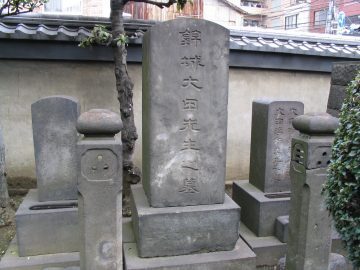
01. The Grave of Ota Kinjo
Metropolitan Historical Site
Ichijyo-ji Temple, 1chome 6-1, Yanaka
Ota Kinjo(1765-1825) is a Confucian scholar in the late Edo Period. His real name is Motosada and popular name is Kokan or Saisa. Kinjo is his name as a scholar. He was born in Daisho-ji Temple in Kaga Province. Kinjo learned Confucianism of Secchu School under the great Confucians, Minagawa Kien and Yamamoto Hokuzan, but was never satisfied with it and personally studied Chinese various theories after the Han dynasty. He consequently found an original school.
In his last years, he spent in Kinai region (present Kyoto/Osaka area) for a period and served Yoshida Domain in Mikawa Province, but Kanazawa Domain in Kaga Province invited him as a guest teacher and provided him with 300 koku.
Kinjo died at 61 on 23th of April in 1825. He wrote a lot of works, such as “Kyukeidan”, “ShunsodoShishu”, “Homeishu” and so on. His eldest son served the lord of Kaga and his third son served the lord of Yoshida as Confucian.
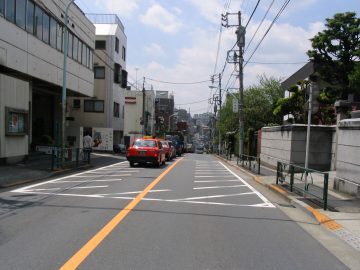
02. Zenkoji Hill Road
1chome 5, Yanaka
This road, also called Shinano Hill Road, was named after Zenkoji Temple which used to be on the top of the hill. Zenkoji was built in 1601 as a temple and lodging place in Edo for the priests of Zenkoji from Shinano (present Nagano Prefecture). It prospered with a busy temple street in front of the main gate. The temple burned down in a huge fire in 1703 and was relocated into Aoyama, but the area name "Zenkoji Monzen-cho" was used for the southern side of the hill until the 5th year of the Meiji Period.
Reference literature from the Edo Period states that the hill road was about 29 meters in length with a 4.5 meters elevation.
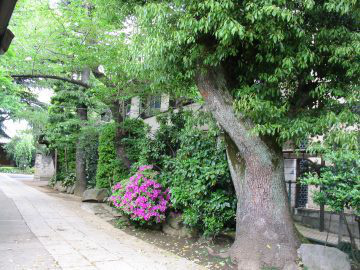
03. Chinquapin Tree of Gyokurinji Temple
Metropolitan Natural monument
Gyokurin-ji Temple, 1 chome 7-15, Yanaka
This is the Castanopsis sieboldii which is located behind the main buildings of Gyokurin Temple. It is about 14.2m high and has about 6.3m trunk circumference. As there was a big empty hole around the roots and big branches were dry and damaged, an operation for recovering was conducted between 1991 and 1993. It is said that it had already been standing when Gyokurin Temple was built in 1591. It is a precious tree as one of few remaining giant Castanopsis sieboldii tree in an urban area. Castanopsis sieboldii are evergreen tall tree belongings to Fagaceae and usually called red oak. The fruits can be eaten, and the timber is widely used for making furniture and others.
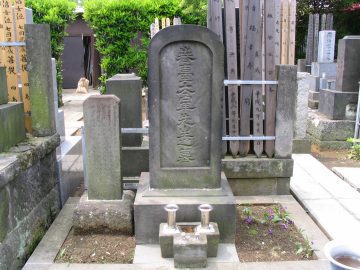
04. Tomb of Dazai Shundai
Metropolitan Historical Site
Tengen-ji Temple, 1 chome 2-14, Yanaka
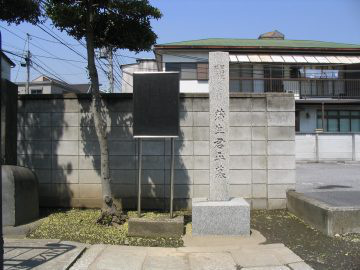
05. Tomb of Gamo Kunpei
National Historic Site
Rinko-ji Temple, 1 chome 4-13
Gamo Kunpei was born in 1768 to a merchant family in Utsunomiya (present Tochigi Prefecture). His common name was Isaburo, familiar name Kunzo or Kunpei, pen name Shusei or Shusei-an. Along with Takayama Hikokuro and Hayashi Shihei, he is known as one of the "Three Eccentrics of the Kansei Era."
During the Kansei Era, in the late 18th Century, he researched all of Japan's imperial tombs and compiled the "San-Ryo-Si." This work is now known as one of the pioneering efforts of the Imperial Loyalist Theory.
He later came to Edo, worked on his writings, and died in 1813. On his tombstone, the famed scholar Fujita Yukoku wrote dedications on its four sides. Selected in 1942 as a national historic site.
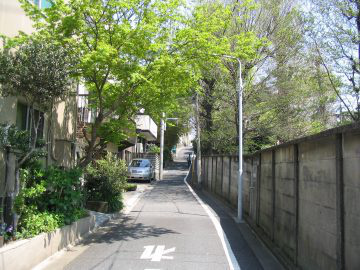
06. Miura-Zaka Slope
1 chome 4, Yanaka
According to a local topography of the Edo Period (1600-1868 ), the slope leading down to Nezu known as Naka (middle)-zaka Slope was also known as Miura-zaka Slope because it led from in front of the third mansion of the Miura family.
The head of the Miura household was the feudal lord of the Katsuyama Clan in Mimasaka Province (present Okayama Prefecture). At the end of the Edo Period the Katsuyama Clan changed its Mashima, and the areas on both sides of Miura-zaka Slope came to be known as Mashima town. Thus, both the name of the slope and the name of the areas on either side of it were connected with the mansion of the Miura family.
It is said that the alternative name of Naka-zaka Slope is associated with the fact that this slope was located in between two other slopes.
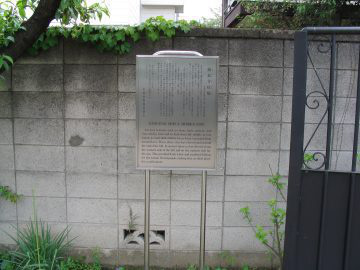
07. Ryogenji Shell Midden Site
Ryogen-ji Temple, 4 chome 3, Yanaka
Ancient remains such as stone tools, pottery, and clam shells, believed to date from the middle to late Jomon Period (3000-2000BC) have been excavated from around here. Three other sites have been found around the end of the hill. In ancient times a river flowed along the western side of the hill and on the eastern side lay the sea. This provided fresh water and excellent fishing for the Jomon Period people, making this an ideal place for a settlement.
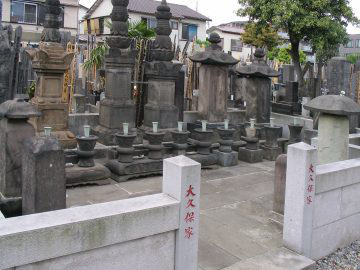
08. Tomb of Okubo Monto
Metropolitan Historical Site
Zuirin-ji Temple, 4 chome 2-5, Yanaka
Okubo Monto, his given name Tadayuki, but he is better known as Togoro. A samurai from Mikawa Province (present Aichi Prefecture) he served Tokugawa Ieyasu and was given a stipend of 300 koku of rice. In 1590, Ieyasu moved to Edo and started to build a town. When Tadayuki was ordered to construct an irrigation system in Edo, he succeeded by drawing water from the largest wells in Musashi Province, Inogashira and Zenpukuji Ponds, to Edo Castle and the town of Edo. This was called the Kanda Canal and not only was it the first waterworks in Edo but the first in Japan as well.
Due to this success, Tadayuki was given the name "Mondo" from Ieyasu and was told that it should he read "Monto" because clear waters are the most noble. Since then, his descendants all used the nickname Monto. Died 1617.
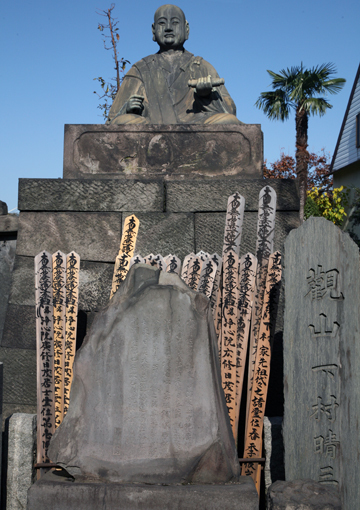
09. Tomb of Shimomura Kanzan
Anryu-ji Temple, 5 chome 3-17, Yanaka
Kanzan was a painter from the Meiji to early Showa Periods. His original name was Seizaburo. He was born in 1873 in Wakayama Prefecture. He loved paintings from an early age and came to Tokyo in 1881. He studied under Kano Hogai and Hashimoto Gaho. Studied at the Tokyo School of Art (now Tokyo University of the Arts), graduated in 1894, and became an assistant professor there. In 1898, he participated in Okakura Tenshin's establishment of the Japan Academy of Art along with Hishida Shunso and Yokoyama Taikan. He later returned to be a professor. He also studied in Europe as a Ministry of Education foreign student. When Tenshin moved his paintings department to Izura Ibaraki Prefecture (present Kita-Ibaraki City), Kanzan, along with Taikan, moved there. In the first Ministry of Education Exhibit in 1907, he entered his "Autumn among Trees" and achieved nide acclaim. In 1912, he moved from Izura and established his new home in Yokohama.
When Tenshin died in 1913, he resurrected the Academy with Taikan in 1914 and contributed to the development of modern art in Japan. Kanzan painted many masterpieces but he was best with paintings with historical themes. Died in 1930 at age 58.
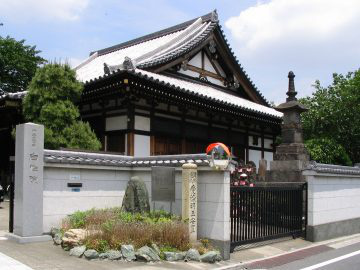
10. Aizen-do Temple
Jisho-in Temple, 6 chome 2-8, Yanaka
Jisho-in is an old monastery which was originally built in Kanda in 1611 and moved to its present position in 1648. It is known for the statue of Aizen Myo-o enshrined in the Aizen-do Hall. The statue is one meter tall and it is said that inside it is the small Aizen Myo-o image which the priest Kankai picked up from the road during his pilgrimage to Mount Koya. People pray to Aizen Myo-o particularly for finding marriage partners and for household harmony.
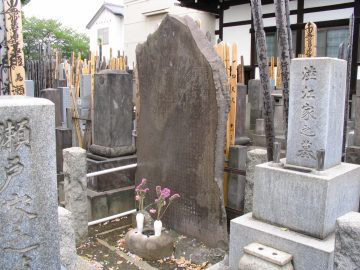
11. Grave of Shibue Chusai
Kanno-ji Temple, 6 chome 2-4
Shibue Chusai was a medical practitioner and Confucian scholar at the end of the Edo Period (1600-1868). He was born in Kanda in Edo (old Tokyo) in 1805, the son of the doctor to the Hirosaki Clan.
In 1844 he became a teacher at the medical school in present-day Asakusabashi 4-chome (the medical school is now the University of Tokyo, Faculty of Medicine). His works include "Keiseki Hokoshi" which he wrote in collaboration with Mori Kien.
In 1858 Chusai caught cholera, dying at the age of 54. He was buried in this temple. It was not until after his death that Chusai's name first became widely known through the biography "Shibue Chusai" by the famous novelist Mori Ogai.
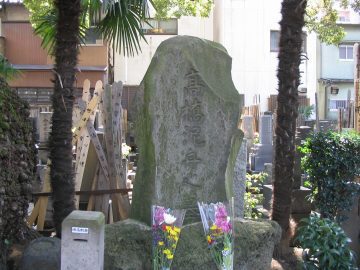
12. Tomb of Takahashi Deishu
Daio-ji Temple, 6 chome 1-26
Takahashi Deishu was a master of spearman ship and a subject of the government in the last days of the Tokugawa shogunate; also, he was a brother-in-law of Yamaoka Tesshu. He was born as a second son of the Yamaokas, and then was adopted into the Takahashi family. His original name was Masaaki, but he was usually called Kenzaburō. He was admired as an expert of the spearman ship and became an instructor of the Military Art School of the government at the age of 21, then became a master at the age of 25.
In 1862 when the supporters of the shogunate and anti-shogunate stood in opposition, the government levied master less samurais in Edo and sent them to Kyoto in 1863. Although he became a leader of the group, later had to quit his post because members of the group cooperated with the supporters of the Emperor. However, he was soon reinstated and became the leader of a guerilla unit. After the battle of Toba-Fushimi, Deishu persuaded the Tokugawa family to obey the Emperor. When Yoshinobu, the 15th Tokugawa shogun swore allegiance to the Emperor and moved to the Kan-eiji Temple, then moved to Mito, he headed a guerilla unit and guarded the shogun Yoshinobu. After the establishment of prefectures in place of feudal domains, he is said to have spent rest of his life enjoying calligraphy in seclusion and he died in February 13th in 1903. He is called "Three shū at the end of the Tokugawa government" together with Yamaoka Tesshu and Katsu Kaishu.

















